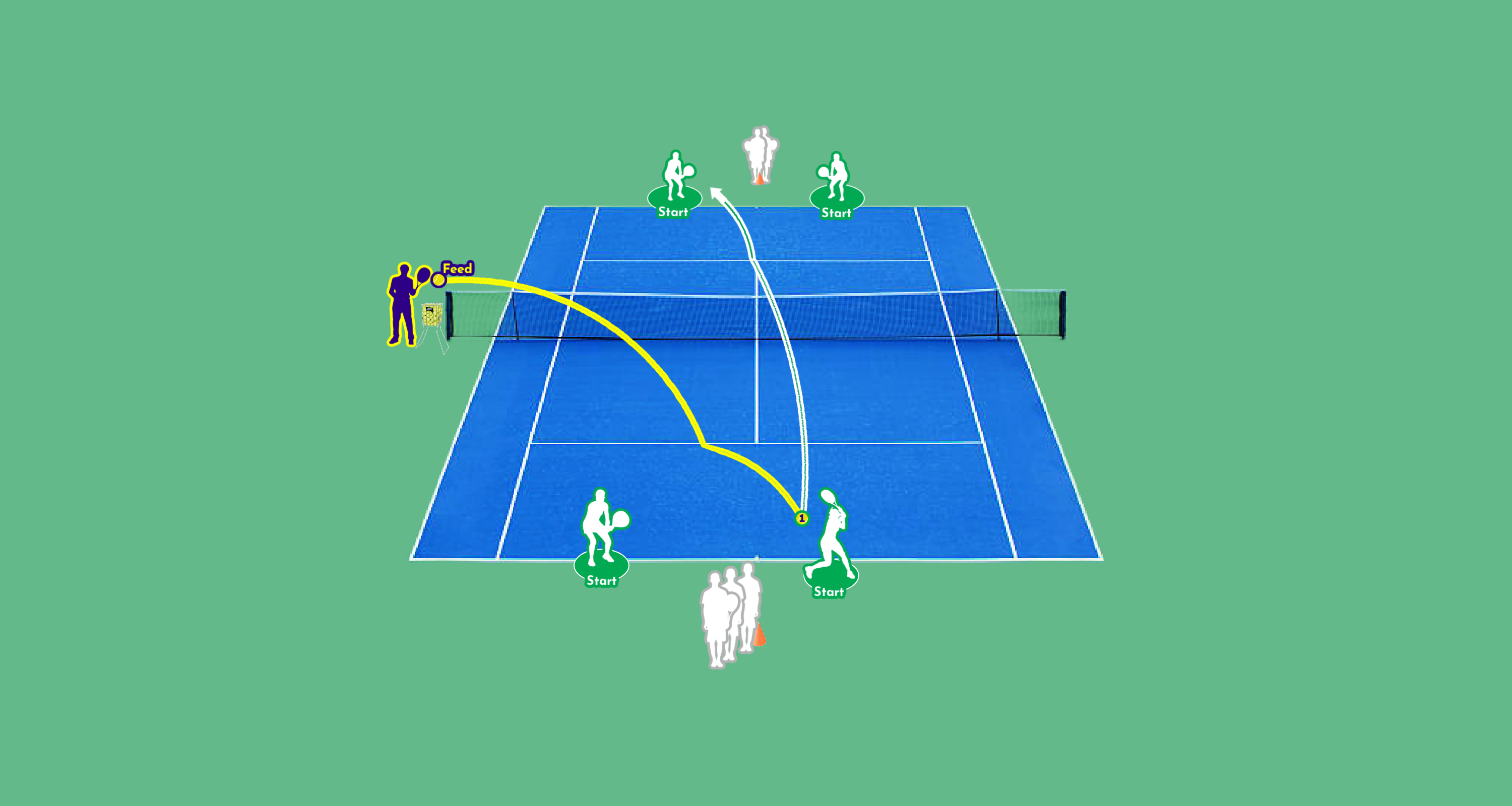
1. Challenge Courts
Explanation
Set Up: One doubles team or singles player will face off against another doubles team or singles player on each baseline. Additional doubles teams or singles players wait for their turn to replace a baseline doubles team or singles player who misses. Players waiting must be in a single file line behind a cone near the back fence. This set up should be on multiple courts, if possible.
Play Description: The coach may feed to any player that is in, which will then start the point. After the point is completed, the winning team or singles player stays in to play the next point. They will stay in until they lose (maximum of three points). The losing team exits to wait behind the cone as the team or singles player previously waiting, now comes in to play the next point. The first team or singles player to reach 15 points (or any predetermined total), on any court completes the round. The highest scoring team or singles player moves up to a higher court for the next round, and the lowest scoring team or singles player moves down to a lower court. All other teams remain on the same court for the next round.
Please Remember: Safety is our first concern. Always have players waiting to play behind a cone or at a safe distance from any danger. The pace of the game will be determined by the level or the number of players. If the level is low, the overall pace should be slower, allowing the players to keep up and receive more coaching feedback.
Levels: Advanced beginner through tournament player
Minimum Number of Players Per Court: 4
Maximum Number of Players Per Court: 10
Minimum Number of Courts:2
Feed Style: Racket Fed or Hand Fed (for lower level players)
Variations
- Freeze for balance and proper technique after each shot
- Consistency (ball must cross a certain amount of times before point starts)
- Controlled pace (ball is hit at 70%)
- Patterns (one side goes crosscourt, other goes down the line)
- Points won by volley or winner worth two points
- Focus on single shot (all slice, forehands, backhands, etc.)
- Depth (every ball must clear the service line)
- No doubles alleys
- Doubles formation
- Start every point with a serve
- Attack short balls (any ball that lands short must be hit and followed to the net)
- Dropshot starts the point (either coach feeds it or first player hits it)
- "Swiss Cheese (Volley Drill)" style
- Lobster style (all players start point touching net as coach feeds a lob)
- Up and Back style (one team/singles player at net, other at baseline)
- Mini Tennis (for lower level players)
- Use real tennis scoring (for low level players to learn)
How to Start
Please see below to learn how to set up and start this game...
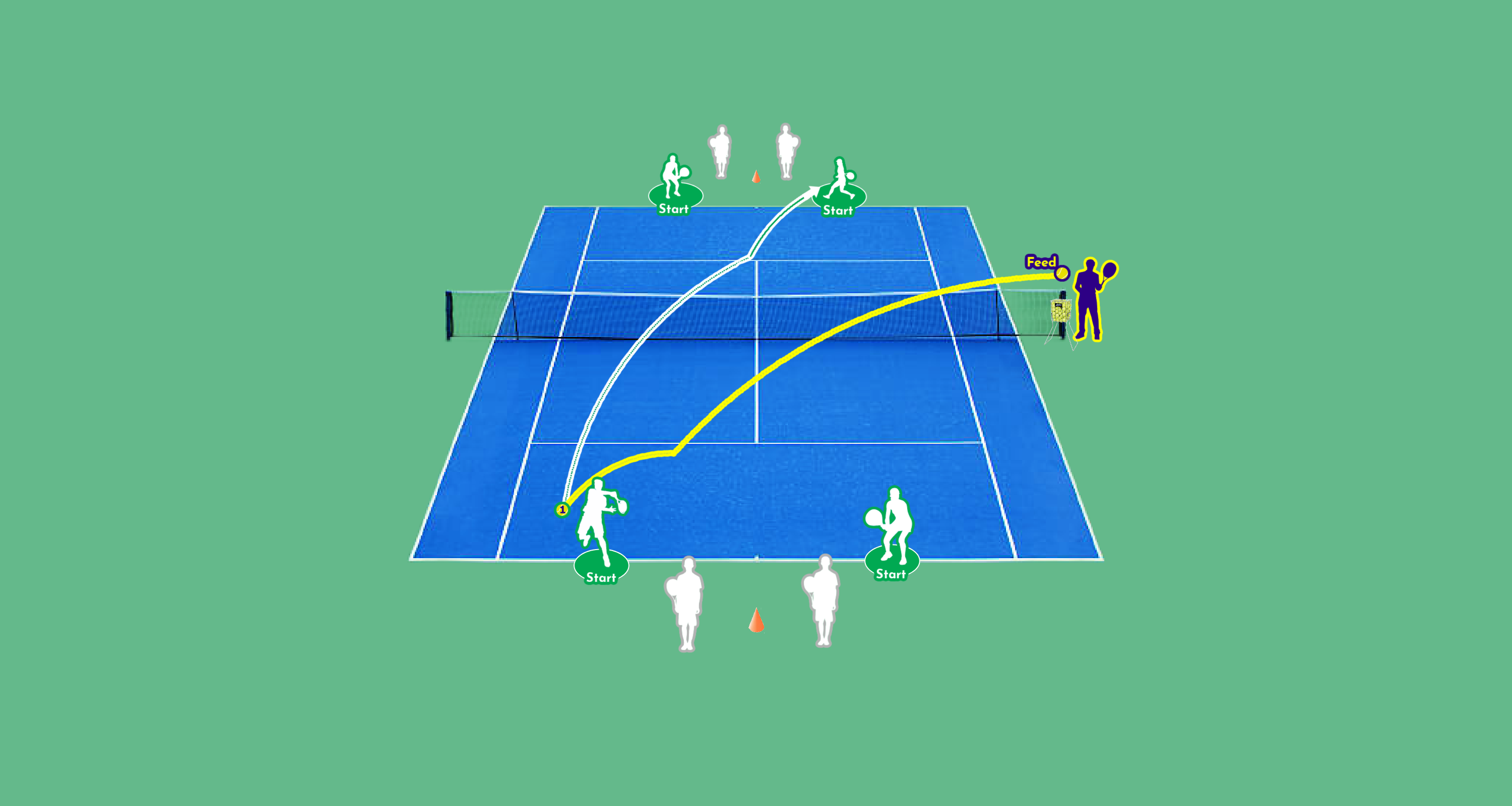
2. Olympics
Explanation
Set Up: One doubles team will be set up at the service line to volley, as two doubles players are on the opposite baseline. Additional players wait for their turn to replace a player who misses. Players waiting must be in a single file line behind a cone near the back fence.
Play Description: The coach must always feed to the baseline players to start the point. After the point, if a baseline player misses, they go to the end of the line. It is single elimination on that side, as the first player waiting in line replaces the missing baseline player. After the point, if a player on the team at the net misses, the team will be assessed an error. Once that net team receives three errors, or a winner is hit against them, they are eliminated at the net and must get in line behind the opposite baseline. After the third error at the net, or first winner, the two baseline players quickly run over to the other side to become the new doubles team at the net. As they are running, the first two players in line replace them. The coach then feeds a high lob for an overhead from the baseline to restart the process of the game.
Please Remember: Safety is our first concern. Always have players waiting to play behind a cone or at a safe distance from any danger. The pace of the game will be determined by the level or the number of players. If the level is low, the overall pace should be slower, allowing the players to keep up and receive more coaching feedback.
Levels: Advanced beginner through tournament player
Minimum Number of Players Per Court: 4
Maximum Number of Players Per Court: 10
Minimum Number of Courts: 1
Feed Style: Racket Fed or Hand Fed (for lower level players)
Variations
- Freeze for balance and proper technique after each shot
- Doubles teams stay together, no single elimination
- Controlled pace (ball is hit at 70%)
- Focus on single shot (all slice, forehands, backhands, etc.)
- Patterns (one side goes crosscourt, other goes down the line)
- No doubles alleys
- Reverse Olympics (coach always feeds to net players)
- Mini Tennis (for lower level players)
How to Start
Please see below to learn how to set up and start this game...
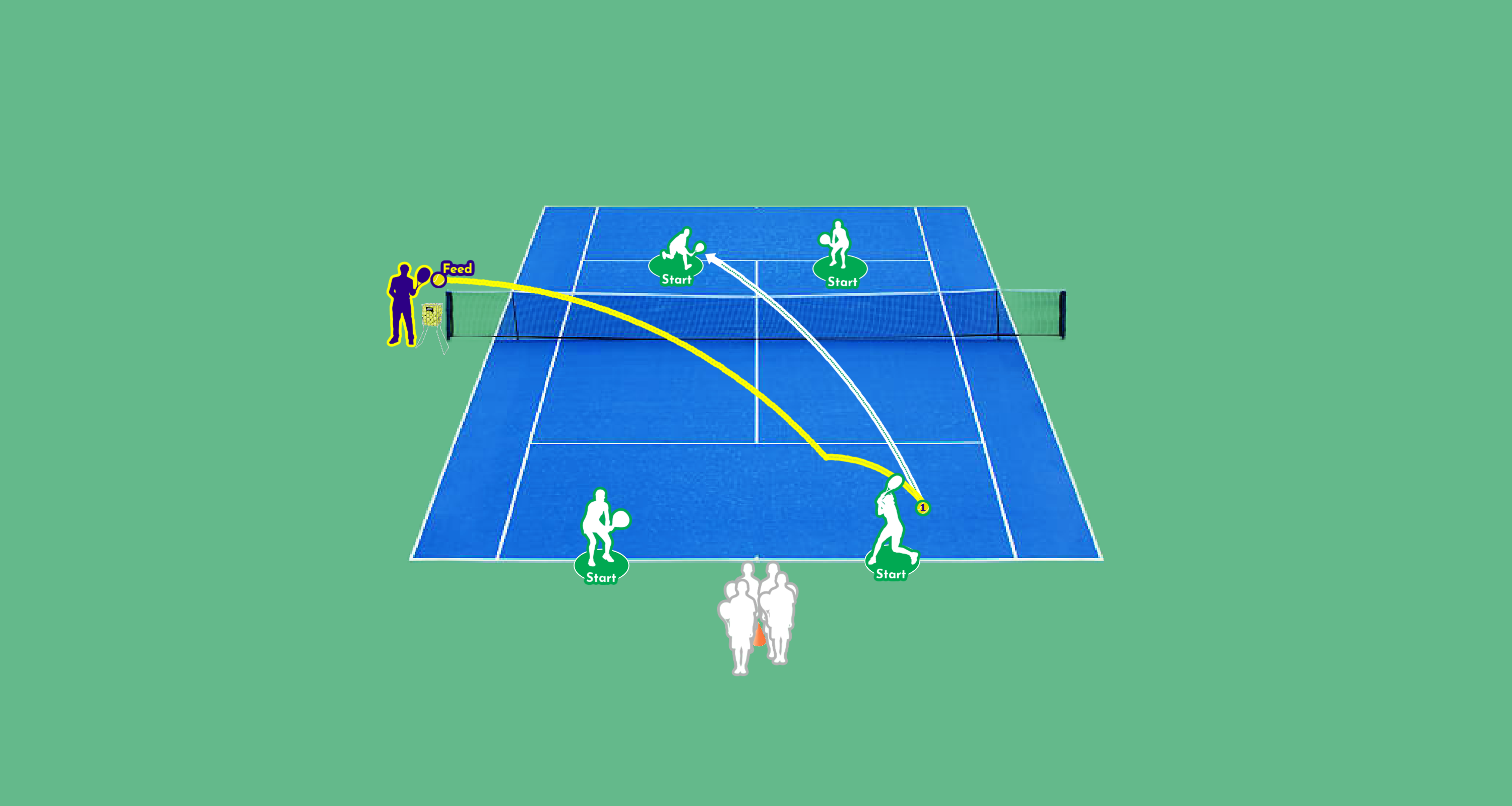
3. Back and Forth
Explanation
Set Up: One doubles team will face off against another doubles team or singles player on each baseline. Additional doubles teams or singles players wait for their turn to replace a baseline doubles team or singles player who misses. Players waiting must be in a single file line behind a cone near the back fence.
Play Description: The coach feeds to the baseline doubles team or singles players to start the point. After the point, if a baseline doubles team or singles player misses, they go to the end of the line. It is single elimination on the baseline side, as the first team or singles player waiting in line replaces the team or player who misses. If the team or singles player at the baseline wins the point, they move up to take the next feed as a volley. As the baseline team or singles player move up for the next feed, the team or singles player previously at the net, quickly move back to the baseline for the next point. If the doubles team or singles player who has moved up wins a second point in a row against the same team or singles player, they then run to the other side and become the new team or singles player. As they are running, the first two players in line replace them. The coach then feeds a high lob for an overhead from the baseline to restart the process of the game.
Please Remember: Safety is our first concern. Always have players waiting to play behind a cone or at a safe distance from any danger. The pace of the game will be determined by the level or the number of players. If the level is low, the overall pace should be slower, allowing the players to keep up and receive more coaching feedback.
Levels: Advanced beginner through tournament player
Minimum Number of Players Per Court: 4
Maximum Number of Players Per Court: 10
Minimum Number of Courts: 1
Feed Style: Racket Fed or Hand Fed (for lower levels)
Variations
- Freeze for balance and proper technique after each shot
- Freeze for balance after each shot
- Add third error to lone team, with third feed as a lob for an overhead
- Single elimination, doubles teams do not stay together
- Controlled pace (ball is hit at 70%)
- Focus on single shot (all slice, forehands, backhands, etc.)
- No doubles alleys
- Doubles formation
- Start every point with a serve
- Freeze after each shot
- Patterns (one side goes crosscourt, other goes down the line)
- Side vs. side scoring
- Mini Tennis (for lower level players)
- Use real tennis scoring (for low level players to learn)
How to Start
Please see below to learn how to set up and start this game...

4. Skyball
Explanation
Set Up: One doubles team will be set up between the service line and the net, as two doubles players are on the opposite baseline. Additional players wait for their turn to replace a player from the baseline who misses. Players waiting must be in a single file line behind a cone near the back fence.
Play Description: The coach must always feed a lob to the doubles team on the net, starting the point with an overhead. After the point, if a baseline player misses, they go to the end of the line. It is single elimination on the baseline side, as the first player waiting in line replaces the player who misses. Once the team at the net commits their third error, the two players at the baseline run over and become the team at the net. As they are running, the first two players in line replace them. The coach then feeds a "sky ball" (super, high lob) for the new team to run over and hit an overhead, after it bounces. From this point, the process of the game continues.
Please Remember: Safety is our first concern. Always have players waiting to play behind a cone or at a safe distance from any danger. The pace of the game will be determined by the level or the number of players. If the level is low, the overall pace should be slower, allowing the players to keep up and receive more coaching feedback.
Levels: Intermediate through tournament player
Minimum Number of Players Per Court: 4
Maximum Number of Players Per Court: 10
Minimum Number of Courts: 1
Feed Style: Racket Fed or Hand Fed (for lower levels)
Variations
- Freeze for balance and proper technique after each shot
- All "Sky Ball" feeds, as net players let it bounce before hitting overhead
- Allow winners to count as third miss
- Doubles teams stay together. No single elimination.
- Controlled pace (ball is hit at 70%)
- Patterns (one side goes crosscourt, other goes down the line)
- No doubles alleys
- Mini Tennis (for lower level players)
How to Start
Please see below to learn how to set up and start this game...
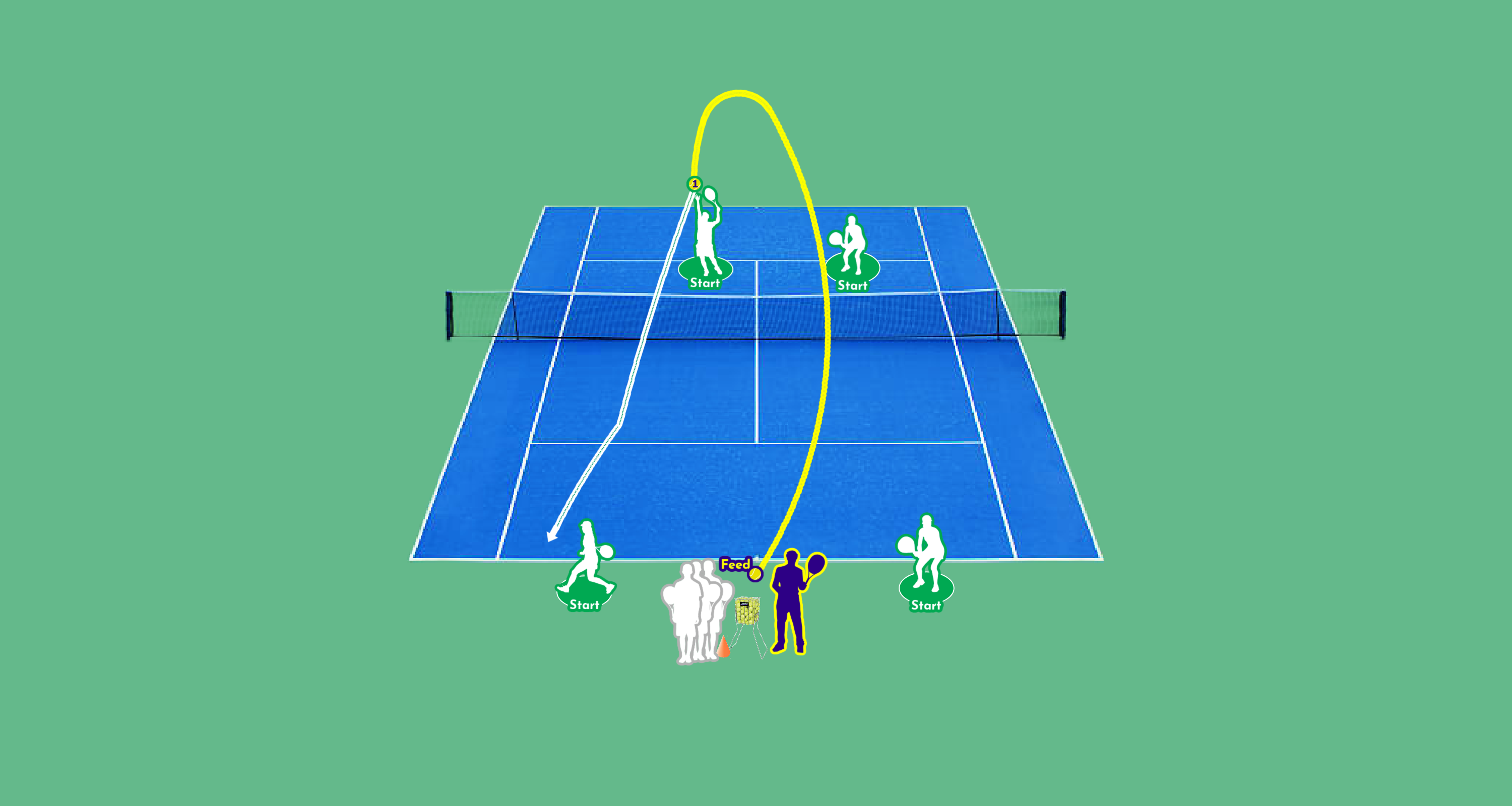
5. Swiss Cheese (Volley Drill)
Explanation
Set Up: Two doubles players will start on each service line to face off. Additional players wait for their turn to replace a player from the service line who misses. Players waiting must be in a single file line behind a cone near the middle of no man's land.
Play Description: The coach feeds a volley to any player on the other side of the net, which will then start the point. The feed must be low, as to not advantage the receiving team. No lobs allowed. After the point is completed, the player who misses goes out to wait in line. Players stay in until they individually miss. The first side to reach 21 points (or any predetermined total) wins, with each group switching sides at 11 points.
Please Remember: Safety is our first concern. Always have players waiting to play behind a cone or at a safe distance from any danger. The pace of the game will be determined by the level or the number of players. If the level is low, the overall pace should be slower, allowing the players to keep up and receive more coaching feedback.
Levels: Advanced beginner through tournament player
Minimum Number of Players Per Court: 4
Maximum Number of Players Per Court: 10
Minimum Number of Courts: 1
Feed Style: Racket Fed or Hand Fed (for lower levels)
Variations
- Freeze for balance and proper technique after each shot
- Doubles teams stay together, no single elimination
- Winners worth two points
- Only count winners as points
- Players must close the net after feed
- No doubles alleys
- Allow lobs, with the players' lines moved off the court for safety
- Controlled pace (ball is hit at 70%)
- Patterns (one side goes crosscourt, other goes down the line)
- Mini Tennis (for lower level players)
- Use real tennis scoring (for low level players to learn)
How to Start
Please see below to learn how to set up and start this game...
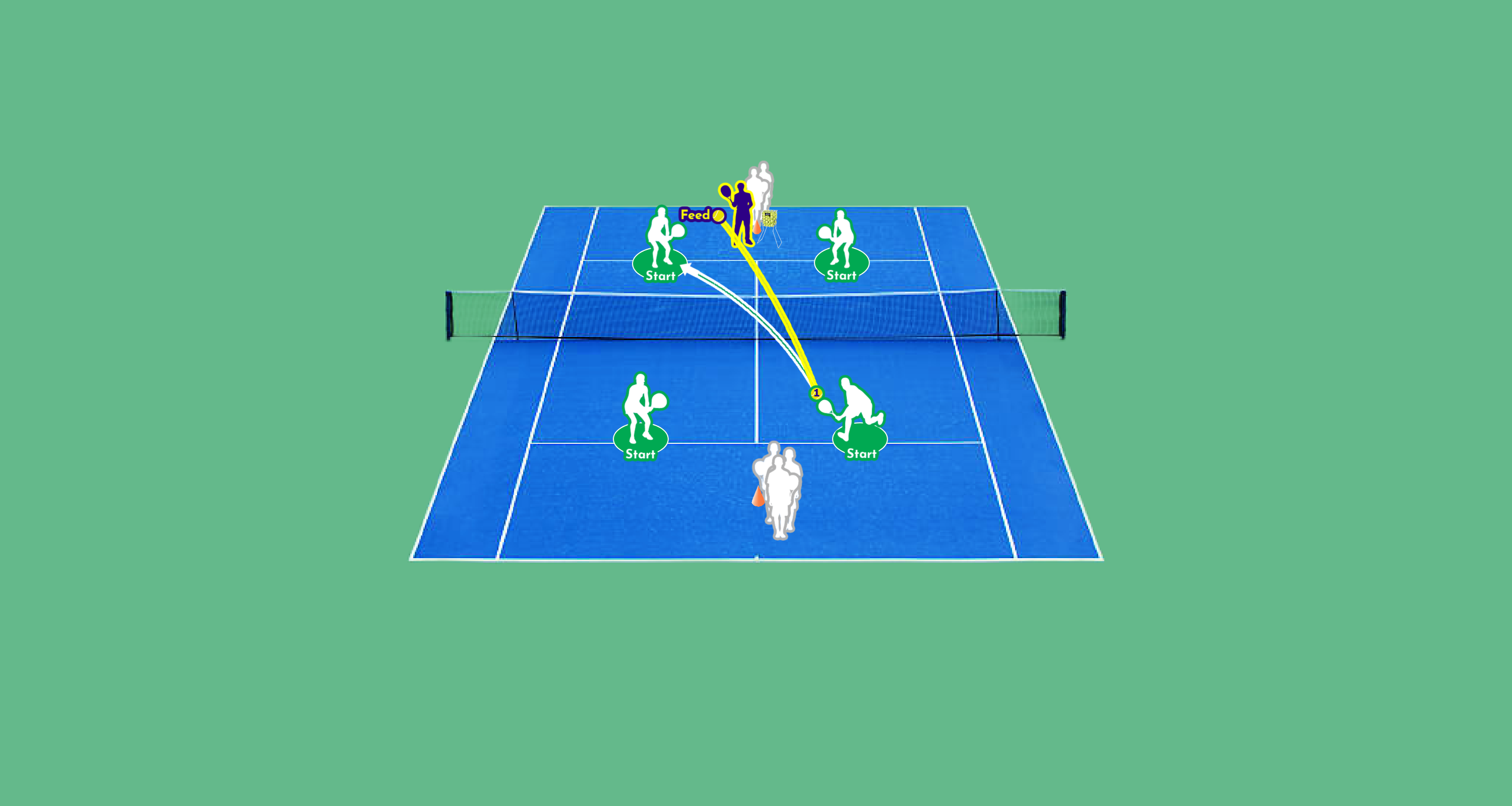
6. Triples
Explanation
Set Up: Three players are in on each side. Two players at the baseline, with their third teammate at the net. Additional players wait for their turn to replace any player on any side, who misses. Players waiting must be in a single file line behind a cone near the net post.
Play Description: The coach must only feed to a baseline player, on either side to start the point. The net players can never cross the service line backwards to hit the ball, and the baseline players may never cross the service line forward to hit the ball. After the point is completed, the winning "Triples" team stays in to play the next point. The player that misses will be replaced for the next point by a waiting player in line. Every "Triples" player on each side will rotate one position clockwise every three points, so that every player has a chance to play at the baseline and the net. Each player keeps track of their individual score, adding to it every time their "Triples" team wins a point. The player that reaches 21 points (or any predetermined total) wins.
Please Remember: Safety is our first concern. Always have players waiting to play behind a cone or at a safe distance from any danger. The pace of the game will be determined by the level or the number of players. If the level is low, the overall pace should be slower, allowing the players to keep up and receive more coaching feedback.
Levels: Advanced beginner through tournament player
Minimum Number of Players Per Court: 6
Maximum Number of Players Per Court: 10
Minimum Number of Courts: 1
Feed Style: Racket Fed or Hand Fed (for lower level players)
Variations
- Freeze for balance and proper technique after each shot
- Consistency (ball must cross a certain amount of times before point starts)
- Controlled pace (ball is hit at 70%)
- Points won by volley or winner worth two points
- Focus on single shot (all slice, forehands, backhands, etc.)
- Only count winners as points
- Start every point with a serve
- Side vs. side scoring
- Mini Tennis (for lower level players)
- Use real tennis scoring (for low level players to learn)
How to Start
Please see below to learn how to set up and start this game...
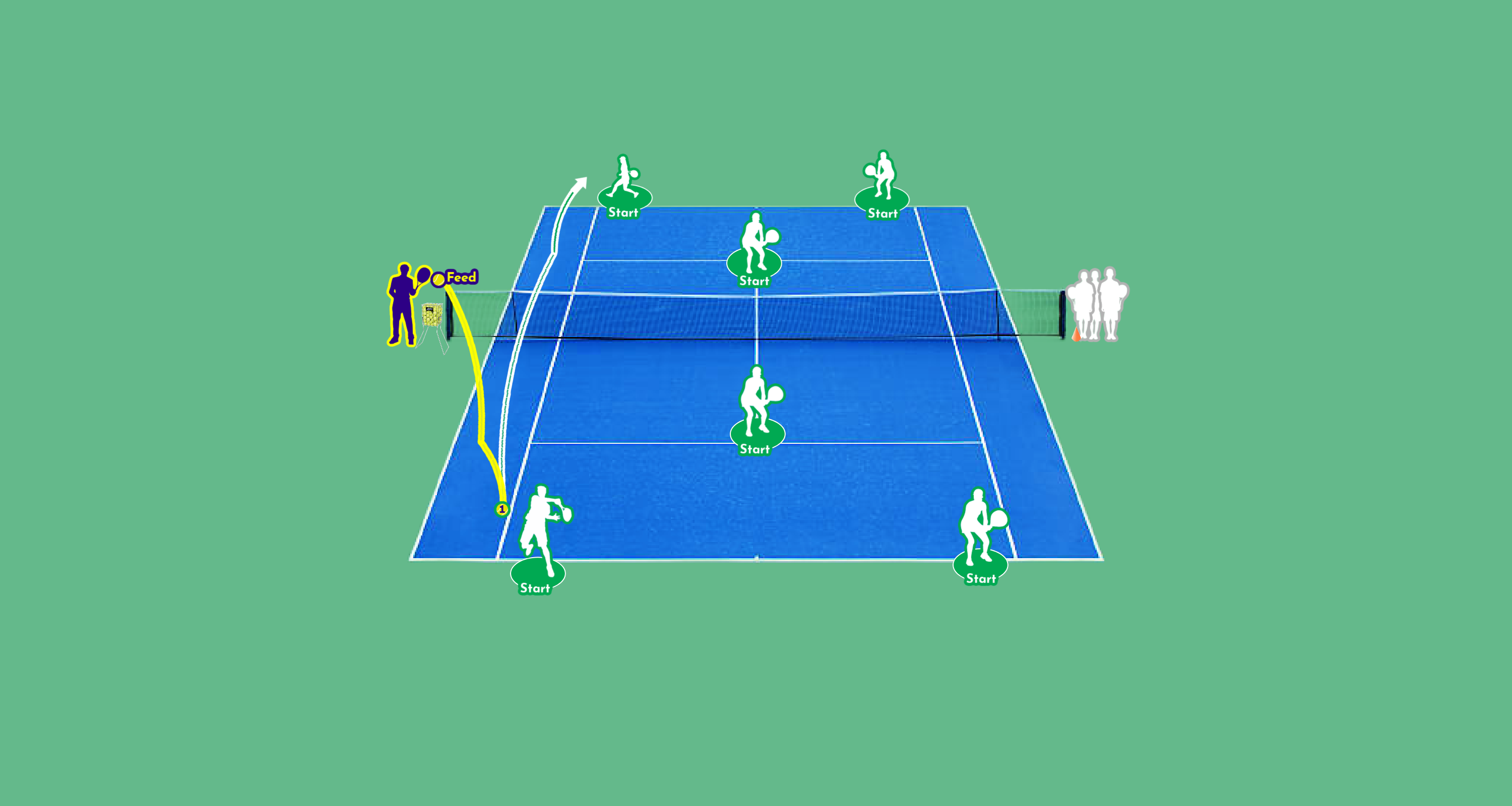
7. Side vs. Side
Explanation
Set Up: Two doubles players will start on each baseline to face off. Additional players wait for their turn to replace a player from the baseline who misses. Players waiting must be in a single file line behind a cone near the back fence.
Play Description: The coach may feed to any player that is in, which will then start the point. After the point, the player who missed exits to wait behind the cone as the player previously waiting, now comes in to play the next point. The winning players stay in to play the next point. and will stay in until they miss a shot individually. The first side to reach 15 points (or any predetermined total), wins the game.
Please Remember: Safety is our first concern. Always have players waiting to play behind a cone or at a safe distance from any danger. The pace of the game will be determined by the level or the number of players. If the level is low, the overall pace should be slower, allowing the players to keep up and receive more coaching feedback.
Levels: Advanced beginner through tournament player
Minimum Number of Players Per Court: 4
Maximum Number of Players Per Court: 10
Minimum Number of Courts: 1
Feed Style: Racket Fed or Hand Fed (for lower level players)
Variations
- Freeze for balance and proper technique after each shot
- Consistency (ball must cross a certain amount of times before point starts)
- Controlled pace (ball is hit at 70%)
- Patterns (one side goes crosscourt, other goes down the line)
- Focus on single shot (all slice, forehands, backhands, etc.)
- Depth (every ball must clear the service line)
- Points won by volley or winner worth two points
- No doubles alleys
- Doubles formation
- Start every point with a serve
- Attack short balls (any ball that lands short must be hit and followed to the net)
- Dropshot starts the point (either coach feeds it or first player hits it)
- "Swiss Cheese (Volley Drill)" style
- Lobster style (all players start point touching net as coach feeds a lob)
- Up and Back style (one team/singles player at net, other at baseline)
- Mini Tennis (for lower level players)
- Use real tennis scoring (for low level players to learn)
How to Start
Please see below to learn how to set up and start this game...
